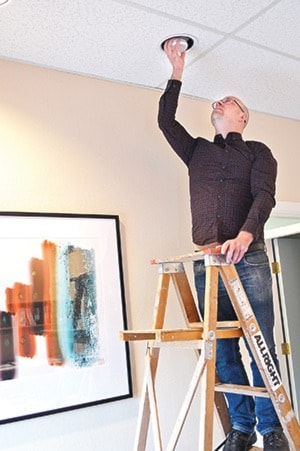In a time when communities are increasingly aware of energy consumption, climate change and environmental impacts, School District 63 (Saanich) is at the front of the pack when it comes to leading by example.
SD63 has reduced its greenhouse gas emissions by 20 per cent below its 2007 levels, and they’re not stopping yet.
The District’s aim is to hit a 33 per cent reduction by 2020, matching the Government of British Columbia’s target that was passed into legislation in 2007.
“It’s challenging, but I believe it’s attainable,” said Trevor Billy, energy manager for the school district.
Substantial equipment changes and upgrades started around 2010, he said, and the list of projects SD63 has undertaken reads like a laundry list of energy efficiency.
New boilers, solar photovoltaic electricity, solar thermal panels, heat pumps in many of the elementary schools, occupancy sensors for lighting and new administrative computers that use about 80 per cent less energy are just some of the upgrades, and have in part also led to North Saanich Middle School — the newest in the District — being certified LEED Gold.
Next up, SD63 is installing LED lighting into many of their facilities, a move that would have been too expensive previously.
“The technology is mature, but the price has really dropped in the last year,” said Billy. “It’s literally one-quarter the cost of even two years ago.”
With the new lighting and a few more shiny new boilers on the way, the District has a good base of efficient equipment; the key now is to work on “operational improvements,” and ensuring a strong educational component goes hand in hand with the new equipment.
“Now I need to make sure the teachers are on board with shutting lights off, students aren’t leaving doors and windows open, administrators know how to use their new computers,” he said.
“It’s not so much about more equipment, it’s about making sure what we’ve got is operating as little as possible.”
Billy stressed that all the upgrades that SD63 has committed to are not only beneficial for the environment, but cost effective as well.
“Everything we do has to meet a cost profile. We have to save enough over a period of time to make it worth it to install,” he said. “It’s one thing to preach energy efficiency, but the price does matter. We’re responsible for our budget too.”
With many of the easier, cheaper upgrades already done, finding ways to bring down that last 13 per cent of emissions could be challenging, but Billy isn’t discouraged.
Instead of looking at the remainder as one large chunk, he’s broken down the goal into manageable steps.
“I try to break it into five years around three per cent each,” he said.
The switch to LED lighting will likely accomplish that percentage marker for this year, and then it’s just about finding the next project, and the next, to continue bringing down the District’s emissions.
“We’re halfway there with half the amount of time,” he said. “It’s nice to see it’s achievable.”
It’s also a way for the School District to lead by example, and show the rest of the community that making a significant reduction in environmental impact is not only possible, but getting easier every year.
“One of our objectives is to participate in a sustainable community,” Billy said. “So part of this is to get the word out, and hope that maybe we’ll inspire people.”
For more information, visit sd63.bc.ca.
